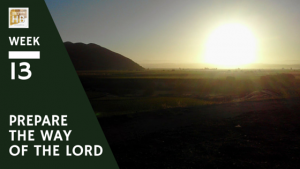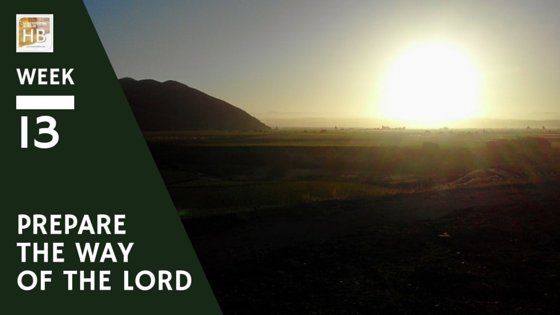Week 13 | Sections 20, 21
 As we continue our chronological reading of the gospels, Jesus has now grown to be a man. This is when the Apostle Mark begins his Gospel record in which he aims to emphasize the activities and miraculous works of Jesus. John was already preparing the way, softening the hearts of his listeners away from self-righteousness and indifference with a message of repentance and baptism of those who desired release.
As we continue our chronological reading of the gospels, Jesus has now grown to be a man. This is when the Apostle Mark begins his Gospel record in which he aims to emphasize the activities and miraculous works of Jesus. John was already preparing the way, softening the hearts of his listeners away from self-righteousness and indifference with a message of repentance and baptism of those who desired release.
Scripture:
Section 20
[one_half last=”no”]Mark1¯2 1:1
1 The beginning of the Good News of Jesus Christ, the Son of God.3[/one_half]
[one_half last=”yes”]Luke 3:1-2
1 Now in the fifteenth year of the reign of Tiberius Caesar, Pontius Pilate being governor of Judea4, and Herod being tetrarch of Galilee, and his brother Philip tetrarch of the region of Ituraea and Trachonitis, and Lysanias tetrarch of Abilene, 2 in the high priesthood of Annas and Caiaphas, the word of God came to John, the son of Zacharias, in the wilderness.[/one_half]
Section 21
[one_third last=”no”]Matthew 3:1-6
1 In those days, John the Baptizer came, preaching in the wilderness of Judea, saying, 2 “Repent, for the Kingdom of Heaven is at hand!” 3 For this is he who was spoken of by Isaiah the prophet, saying, “The voice of one crying in the wilderness, make ready the way of the Lord. Make his paths straight.” 4 Now John himself wore clothing made of camel’s hair, with a leather belt around his waist. His food was locusts and wild honey. 5 Then people from Jerusalem, all of Judea, and all the region around the Jordan went out to him. 6 They were baptized by him in the Jordan, confessing their sins.[/one_third]
[one_third last=”no”]Mark 1:2-6
2 As it is written in the prophets, “Behold, I send my messenger before your face, who will prepare your way before you: 3 the voice of one crying in the wilderness, ‘Make ready the way of the Lord! Make his paths straight!’ ” 4 John came baptizing in the wilderness and preaching the baptism of repentance for forgiveness of sins. 5 All the country of Judea and all those of Jerusalem went out to him. They were baptized by him in the Jordan river, confessing their sins. 6 John was clothed with camel’s hair and a leather belt around his waist. He ate locusts and wild honey. [/one_third]
[one_third last=”yes”]Luke 3:3-6
3 He came into all the region around the Jordan, preaching the baptism of repentance5 for remission of sins. 4 As it is written in the book of the words of Isaiah the prophet, “The voice of one crying in the wilderness, ‘Make ready the way of the Lord. Make his paths straight. 5 Every valley will be filled. Every mountain and hill will be brought low. The crooked will become straight, and the rough ways smooth. 6 All flesh will see God’s salvation.’ ”[/one_third]
Group Dialog:
- How have you personally been transformed by the Gospel of Jesus?
- How might our church and community be transformed if we engaged in active dialog about the reality of our faith. asked and listened to the stories of others?
- How does daily repentance help prepare your heart and mind to be messengers of the Gospel, and a servant of God?
- As the ministry of John the Baptist is focused on repentance, give space at the close of today’s study for a silent confession, and perhaps shared affirmation of faith using the Nicene creed.
- Think back on your baptism (infant or adult) share a related lesson of faith and God’s faithfulness that you hold dear, that gives you strength as you continue in the faith.
Learning Objectives:
Repentance, record of your journey in faith, baptism, dedication, inward transformation, sacrament, sincerity, peace, right living, fulfillment of prophesy, vocation.
Study Notes:
- Mark the Evangelist, is usually identified with John Mark, the cousin of Barnabas. He was not one of the Apostles. According to Eusebius of Caesarea (Eccl. Hist. 2.9.1–4) Peter went to Antioch, then through Asia Minor (visiting the churches in Pontus, Galatia, Cappadocia, Asia, and Bithynia, as mentioned in 1 Pet 1:1). Peter arrived in Rome in the second year of Emperor Claudius (AD 42; Eusebius, Eccl, Hist. 2.14.6), and somewhere on the way, Mark joined him as travel companion and interpreter. Mark the Evangelist wrote down the sermons of Peter, thus composing the Gospel according to Mark (Eccl. Hist. 15–16), before he left for Alexandria in the third year of Claudius. In AD 49, about 19 years after the Ascension of Jesus, Mark traveled to Alexandria (Acts 15:36–41). That was when the Church of Alexandria was formed. He is also honored as the founder of Christianity in Africa. According to Eusebius (Eccl. Hist. 2.24.1), Mark was succeeded by Annianus as the bishop of Alexandria in the eighth year of Nero (62/63). Coptic tradition says that in AD68 Mark was martyred by a rope which was around his neck with which he was subsequently dragged him through the streets until he was dead.
- Mark’s Gospel is more brief than the others, and chronicles the activity and teachings of Jesus more sequentially than the others. At Robinson wrote in the prologue of the Harmony of the Gospels he laid out that, “It is now known that Matthew and Luke made use of Mark for the framework of their Gospels. This change simplifies amazingly the unfolding of the narrative.”
- Mark begins typically short and sweet, whereas in Luke 3:1-2, Luke takes great pains to identify the timing of the emergence of John the Baptist onto the world scene through the identification of the persons of authority in power in various areas. The matrix overlay gives a very specific time frame. We see Luke doing this in other parts of his Gospel; it just seems he makes the point that this particular moment of the Forerunner, John, is to prepare us for the fact that Jesus does also come onto the scene as a real live historical person.
- In 63 BC, Judaea became a protectorate of Rome. Coming under the administration of a governor, Judaea was allowed a king; the governor’s business was to regulate trade and maximize tax revenue. While the Jews despised the Greeks, the Romans were a nightmare. Governorships were bought at high prices; the governors would attempt to squeeze as much revenue as possible from their regions and pocket as much as they could. Even with a Jewish king, the Judaeans revolted in 70 AD, a desperate revolt that ended tragically. In 73 AD, the last of the revolutionaries were holed up in a mountain fort called Masada; the Romans had besieged the fort for two years, and the 1,000 men, women, and children inside were beginning to starve. In desperation, the Jewish revolutionaries killed themselves rather than surrender to the Romans. The Romans then destroyed Jerusalem, annexed Judaea as a Roman province, and systematically drove the Jews from Palestine. The Diaspora.
-
The first reference to John’s ministry with water in this parallel group is in Matthew referring to John the BAPTIST, where baptist is one who baptizes, and the universal implication of water. But Luke (and then Mark quickly) is the first to identify what it is that John is doing with this baptism, that is, a baptism of repentance for the forgiveness of sins. Matthew closes his parallel section here with his reference to what is taking place, that is, the people confessing their sins were then baptized.
From a Christian perspective looking backward, before Jesus, it is too easy to equate one baptism with another. But even apostles knew there was a difference as the reference was made in Acts in the statement that the disciples they discovered had only been baptized with the baptism of John. As well, ask a practicing Jew today if Jew’s practice baptism, and they would say emphatically No — and then go on to describe mikveh, a ritual cleansing, in water, whole body, sometimes daily.
The point would be the intention and purpose. For John would certainly know about ritual cleansing with water (and the Greek old testament would make use of the word baptizo to describe a spectrum of such cleansing); however, John was preaching not an outward cleansing but an inward cleansing for righteousness, the ultimate goal being the Jews being convicted of their failure in the Law, thus their sin, and having a method of a spiritual cleansing of those sins. In the reference in Acts, the “password” if you will is by whom or in whose name was the baptism enacted? John or Jesus, because Jesus would define the meaning and power of his baptism immensely.
The term baptism itself is not simply answered. Just a cursory look at the various Christian denominations and their understanding – locked into doctrinal practice – tells us of the variants. As how physically, early Christian art depicting the baptism of new converts shows a baptizer standing in water, and a baptizee also standing in water, sometimes in shallow water with the action of having water poured over the head, and sometimes in much deeper water with the action of going under in immersion. Interestingly, the ritual cleansing of the Jews (which they say is not “baptism”) is generally understood to be a full covering – usually immersion – in order for it to be a ritual completion.
